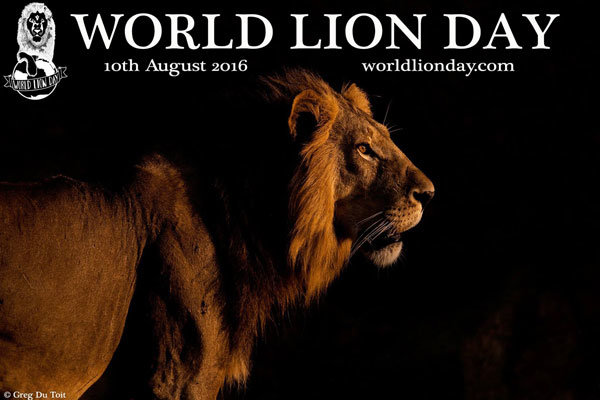
Nowadays
specific symbolic days are celebrated in order to increase the awareness
of the public to preserve animal species across the globe. In this
article, I am going to describe briefly the importance of these symbolic
days for the conservation of fauna.
Let us take the August 10, “World Lion Day,” as an example. Lions are found only in Africa, (Angola, Benin, Botswana, Burkina Faso, Cameroon, Central African Republic, Chad, Congo, Ethiopia, Kenya, Malawi, Mozambique, Namibia, Niger, Nigeria, Senegal, Somalia, South Africa, South Sudan, Sudan, Swaziland, Tanzania, Uganda, Zambia, and Zimbabwe), and India in Asia. Every year those who are interested in conserving lions celebrate “World Lion Day” to increase awareness about the necessity of conserving the “king of the jungle.” Unfortunately, the number of lions is decreasing each minute, and as such they need to be conserved.
The Persian lion (scientific name: Panthera leo persica – common name: Asiatic lion) has always been a symbol of greatness, strength, and courage for Iranians, and that is why we can see the symbolic Persian lions on the walls of ancient monuments, porcelain, coins, handmade carpets, jewelry, stamps, and even architecture in Iran. This subspecies was first seen in Persia in 1826 by an Austrian zoologist, Johann N. Meyer, and therefore the scientific name of Felis leo persicus was selected. However, the scientific name was changed to Panthera leo persica afterwards.
The Persian lion was once distributed across the edge of the Mediterranean Sea, northern Greece, Turkey, and Iran to the Indian subcontinent, including the present-day Pakistan, India and Bangladesh. In Iran, the Persian lion was distributed across the forests around the Karkheh, the Dez, and the Karoon Rivers as well as Masjed Soleyman and Ramhormoz in Khuzestan, Bushehr, and Kazeroon and Dasht-e Arzhan in Fars.
The Persian lion’s habitat in Iran used to be grasslands, marshlands, brush, woodlands, and plains close to the waters. Deer, wild boar, Persian zebra and Persian fallow deer were the main prey of the Persian lion. Most unfortunately, this subspecies became extinct in Iran in 1942 due to habitat loss, prey loss, poaching, and human-wildlife conflict. It turned into an eternal myth in Iran. Today, there are only 523 individuals in the Gir Forest National Park, Gujarat State, India.
It is vital to increase the awareness of the public in order to conserve the animal species of our planet. Most unfortunately, not only the Persian lion is being forgotten in Iran, but also the attention towards other animal species is decreasing every day. Most Iranians do not care for fauna, and the Department of the Environment (DoE), which is in charge of preserving Iran’s flora and fauna, has focused only on the conservation of the Asiatic cheetahs. However, the DoE has been even unsuccessful in conserving cheetahs as they get killed repeatedly by poachers or in car accidents, etc.
It is indeed necessary to pay attention to all animal species instead of paying attention to only one. No one wishes that brown bears, Asiatic black bears, Persian leopards, Asiatic cheetahs, etc. go extinct in Iran. Thus, celebrating symbolic days such as “World Lion Day,” which is missing from Iran’s calendar, could be a great boost to increase public awareness about the conservation of Iran’s fauna. That is the task that falls to the DoE.
Hence, I would like to bring this important issue to the attention of the authorities in charge. Please use the public’s power to preserve Iran’s fauna. Fauna do not only belong to the current generation. They also belong to the future generations, and as such they are to be preserved at any cost.
http://www.tehrantimes.com/news/405171/The-need-to-increase-public-awareness-about-preservation-of-fauna
No comments:
Post a Comment